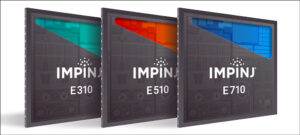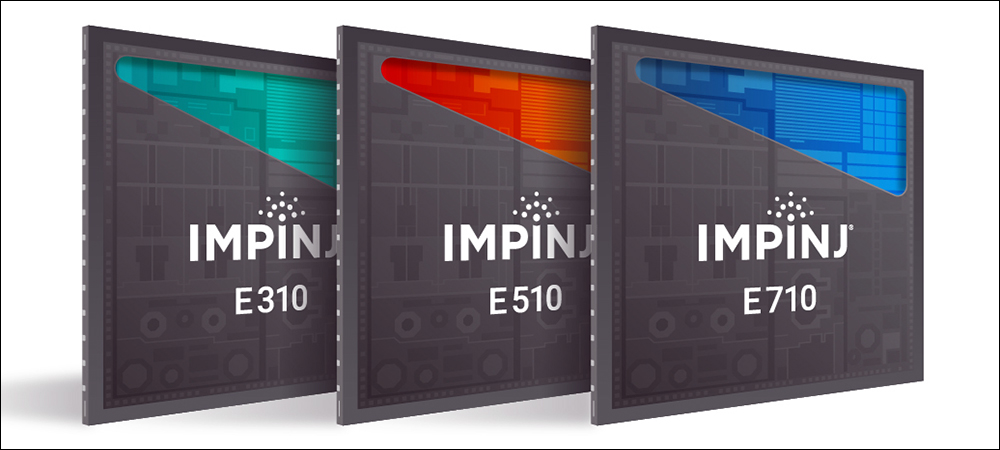Impinj, a Seattle-based technology company, has released three new RAIN RFID reader chips that it says will enable a wide variety of new applications (RAIN is a branded version of UHF RFID technology). The three new reader chips (models E710, E510 and E310) are designed to provide higher performance and lower power consumption than its predecessor products. As system-on-chip (SoC) products, they come with an integrated transceiver, a modem and a microcontroller, all on a single IC, enabling a smaller RFID reading package that can be more easily integrated into readers and other devices. The reader chips are available now in volume.
For RFID reader device companies, Impinj reports, this results in higher performance products. In addition, businesses that design RFID modules to be built into other devices can sell their products to a wider pool of users, ranging from appliance manufacturers to access-control technology makers. “Not only are we introducing chips to push new levels of performance,” says Matt Branda, Impinj’s VP of products, “but also new levels of integration to make the designing of RAIN RFID connectivity easier.”

The goal, according to Branda, is to provide an easily integrated, high-performance product to serve Internet of Things (IoT) applications that are growing more diverse. With the new reader chips, he says, developers can quickly design IoT devices using a single chip. So far, Impinj has announced 17 new products from OEM device manufacturers that leverage the chips, including CAEN RFID, Chainway, Convergence Systems Ltd., Hopeland, JADAK and MTI.
The three chips enable devices to identify hundreds of tagged items per second, Branda reports, with greater sensitivity and a longer battery life than predecessor ICs. The company says it provides up to twice the receive sensitivity, while enabling 80 percent smaller RFID reader designs, using approximately half the power. It can thus be operated with mobile, battery-powered, energy-efficient devices. The chips also come with designs for software- and pin-compatible performance upgrades.
This new IC family is Impinj’s first major upgrade for reader chip technology since the company’s Indy product family was introduced a decade ago. The firm also produces RFID readers, including the Speedway and R700 models. With the latest chips, Branda says, “We are enabling partners to build a wide range of mobile and fixed readers that meet similar performance levels [as Impinj’s own readers].”
Of the three chips, the E710 provides the highest performance, the company reports, and thus supports RIFD monitoring of crowded or challenging environments, such as busy warehouses. The chip is optimized for use in portals or other fixed readers, as well as with inventory-counting robots and high-performance handhelds for capturing tag IDs from a distance. For instance, the chip can provide a read range of approximately 10 meters (32.8 feet) for tagged goods stored on shelves or pallets, or packed in cartons.
The E710 comes in a 6-millimeter by 6-millimeter (0.24-inch by 0.24-inch) package and includes a radio modem, self-jammer cancellation, RF front-end, a microcontroller and power regulation. It is designed to increase the speed and accuracy of RFID tag reads, the company explains, with 4db improvement over the highest-performing Indy reader chips. The chip can be used for fixed readers that can be built into shelves and cabinets to read goods stored in and dispensed from vending systems.

Matt Branda
The E510 is the mid-range option, in terms of price and performance, and is optimized for battery-powered devices. The chip is the same size as the E710, with the same SoC features, and is intended to read and write data from and to tags near or far in an energy-efficient manner. It is being built into point-of-sale devices or touch-free shopping kiosks, as well as smart, connected-home appliances. For instance, a smart refrigerator could incorporate an RFID reader that interrogates tagged goods stocked inside it, providing home owners with information regarding what is in their fridge, as well as when it might expire.
The lower-cost E310 delivers performance optimized for close-proximity devices, Impinj reports. According to the company, the chip is designed to be embedded into printers, gaming devices and security systems to enhance consumer electronics. The chip can also be used for access-control devices, the firm notes, to provide RFID reading of ID cards at a greater distance than with LF- or HF-based systems, with higher performance and at a lower tag cost.
Businesses using the new chips include purpose-built RFID reader makers, as well as device companies not primarily focused on RFID that wish to add RFID functionality to their existing products. In the former scenario, the system improves reader hardware performance, while in the latter, it enables new use cases. For Impinj, which designs and sells its own complete RFID reader systems, the purpose is to expand the options for those wishing to leverage RFID reads. “It’s about growing the industry,” Branda says.
As RFID expands into new industries, Branda says, the chips are intended to enable partners to build a myriad of devices. The primary use case for RFID technology, he explains, is inventory management via handheld readers at retail locations, in addition to RFID-enabled conveyors and portals in the supply chain. But other use cases are opening up, he notes. In the supply chain, employees increasingly need to expand when and how they read tags. That is leading to the development of RFID reading wearables, such as wristbands, that allow them to create inventory points across the supply chain.
While the retail market represents the highest volume of RFID technology users, several companies in the food industry are piloting or deploying RFID in a variety of ways this year, including tagging goods for self-service kiosks, cold chain condition monitoring and inventory tracking. These new applications may demand more versatility on the part of RFID technology providers, Branda says. In stores, for instance, cabinets could enable self-service vending or food sales, with individuals presenting a payment, then opening the cabinet door to remove they wish to purchase. The reader built into the cabinet would then detect which tagged items were removed and charge the customer’s account automatically.
The size and potential utility that RFID brings to the food industry, Branda says, creates a potentially large market that is still in its early days. “Everything from printing to reading will evolve,” he states, “and needs a little more flexibility.” If food labels employ RFID, for example, staff members may need to print labels at the shelf-side as they update pricing. “I believe you’re going to see more variety and ubiquity in where and how you can deploy RAIN RFID, connectivity.”
Branda forecasts that RFID will evolve beyond traditional readers to the embedding of RFID reading into existing IoT devices. RFID read functionality, he says, can more easily be embedded into tablets and other mobile device used in warehouses or distribution centers, with the new chips. Three companies so far have developed new handheld readers leveraging the new chips. Chainway offers two new wearable readers and its CRP30 printer and handheld reader, while Hopeland Shine has developed a fixed reader. According to Branda, a total of 10 new modules have been developed.
The E710, E510 and E310 reader chips are pin- and software-compatible, according to Kate Wang, Chainway’s marketing manager “which significantly reduces the complexity of our module designs and enables us to quickly deploy new modules into our wide range of RFID devices.” That, she says, allows Chainway to get new products to market faster and reduce development risk. Chainway is using the E710 for its handheld reader and printer. “Also, while maintaining industry-leading performance, the new chips have been greatly reduced in size,” Wang states, “enabling us to develop modules that are much smaller than before and realize the development of more lightweight and compact handheld and wearable readers.”


